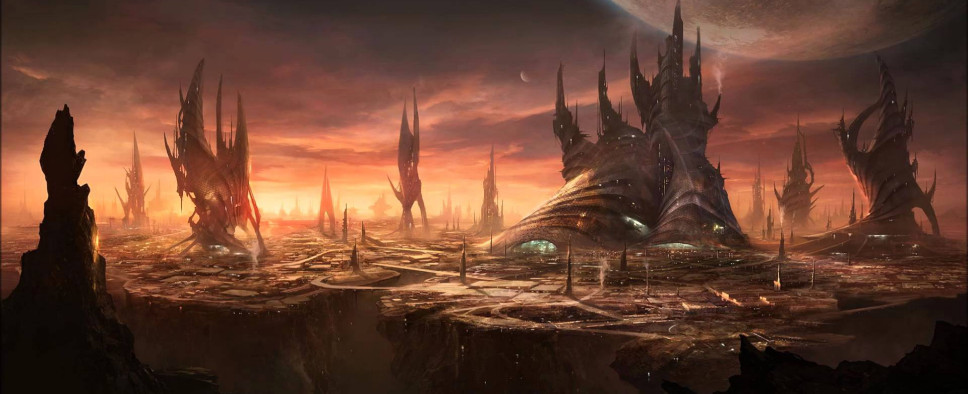Introduction
While I can’t say I’m completely unfamiliar with Paradox Development Studio’s output, the preview build of Stellaris marks the first time I’ve actually immersed myself in one of their grand strategy games. It’s also a first for the development team, as it marks the first time they develop a title that isn’t bound by the past and instead imagines the future.
Of Tutorials and Space Exploration
Stellaris starts by letting the player create an empire or choose from a number of pre-made empires, such as, for example, the United Nations of Earth. A starting empire will have a single primary species (later on, when expanding, the empire will begin to integrate more alien species, which can bring interesting challenges and bonuses), a homeworld which will also determine the primary species’ habitat preferences, a set of ethics and a government compatible with those ethics, and a starting weapon and FTL travel method for the empire’s ships. The goal of the game is to expand your empire throughout the galaxy either by colonizing enough planets or crushing the other empires.
It is quite a lot to digest — especially for a genre newcomer — but the upside is that creating an empire from scratch is undeniably satisfying. If you personally prefer to explore space with a colony of sentient mushrooms that travel from a system to another with a wormhole generator, Stellaris simply says “be my guest.” Some of these choices have mechanical effects, of course, but personally I found that it’s the flavour that really sells the game experience.
Take the tutorial, for example. The majority of tutorial messages are fully voiced and written in-character. New players are guided by an artificial intelligence with a cheeky but underplayed sense of humor. Sure, science ships need to be manned by a scientist leader, but really, it’s only saying that because its on-board programming forces it to do so! Stellaris’ prose could have quickly turned into a farce in the hands of less skilled writers, but thankfully Paradox understands that humorous remarks like that are best used in moderation.
The same philosophy doesn’t carry over to the actual design of the tutorial, unfortunately. Stellaris is supposed to be a more gentle and welcoming introduction to Paradox’s own brand of strategy and dynamic, emergent gameplay and storytelling (more of my thoughts on that later), but the tutorial bombards the player with numbers and concepts right from the very start. Very few systems in Stellaris feel particularly complex or convoluted on their own, but on the flipside, there is a system for everything.
For example, it’s possible to both implement planet-wide edicts and also change the entire empire’s policies, and those are two different things. On top of that, the current ruler of the Empire will bring his or her own set of bonuses to the empire, as the governor of a planet will for the planet under their own jurisdiction. Said planets can be micromanaged too, but there’s a limit to how many planets can be directly controlled, and eventually a player will have to create sectors that the AI will micromanage for them.
In other words, Stellaris is a dense game. It starts simple, however. One of the reasons I think Stellaris’ tutorial is bad is that there really is no reason to introduce so many concepts early on. At the beginning, if taken at its core, Stellaris is a surprisingly simple game of expansion and resource gathering. At the start, you control a single planet inside a solar system. The goal is simply to set up some mining and research stations to obtain more resources and expand into neighboring systems.
Stellaris makes use of a variety of resources, but the most important and fundamental are three. Energy credits are essentially Stellaris’ way of conflating money and power. They are generated from power plants or can be obtained from mining stations orbiting around other planets or celestial bodies. Normally, they’re simply used for the maintenance of the empire’s various buildings, ships, armies and orbiting stations. Minerals, on the other hand, are similarly obtained from mining stations and mineral networks and silos on the empire’s planets. They are used to build ships, buildings and stations, and they’re by far the most intuitive resource in the game. For the most part, minerals are only used when you decide to build something.
Finally, there’s influence. That’s a tricky one, because it feeds in many of the game’s political systems and essentially governs the rate of your empire’s expansion. You begin the game with around 150 points of influence, with a monthly gain of 3. Influence is used for things such as implementing edicts, recruiting a new leader (such as scientists for researches or science ships or governor for your empire’s various planets), and setting up frontier stations. Frontier stations are needed to expand the borders of the empire, but they aren’t cheap. Each of them costs 200 influence points and also permanently drains one influence point from your empire monthly. Assuming no other sources of influence, as little as three frontier stations will effectively kill any monthly influence gain.
There are, of course, ways to gain more influence. For example, some society technology will give a monthly boost to influence once researched. Similarly, declaring another empire a rival will offer a monthly boost to influence, though one that comes at the cost of their overall opinion. Declaring a vastly superior empire a rival might seem like a good move in the short term, but it might eventually push them over the edge and convince them to declare war.
I mentioned research earlier, which is another important element of the game throughout the entire duration of a playthrough. Research is divided into physics, engineering and social. Every category draws a number of new technologies to potentially research once the current research is completed, from which a player can choose. How much time it will take to complete a research is determined by a variety of factors, chiefly the technology resources acquired via research stations, and the scientist leaders’ own abilities.
New technologies do about what you’d expect. They give you more options to build your ships (there is a ship designer in the game, although I didn’t find it to be too interesting or necessary), and buildings, give you bonuses and, most importantly, allow for new actions. The sci-fi setting allows Stellaris the opportunity for some really interesting mechanics. It’s possible, for example, to uplift a primitive species from the stone age to space travel and make them your vassals, or to find a civilization on the edge on the edge of nuclear apocalypse and offer them another chance in the stars. It’s in that kind of moments that Stellaris really hooked me, during the times where the prose, the ambience and the mechanics intermingled to form something fantastic.
Unfortunately, so far I haven’t encountered quite as many of those moments as I had wished.
Of Empires and SPACE DIPLOMACY!
I greatly enjoyed my initial experience with Stellaris. In spite of the overwhelming tutorials, I immediately found a simple but compelling gameplay loop in my empire’s expansion throughout the stars, and I genuinely looked forward to the thought of unpacking some of the more subtle and unclear systems, like the ethics divergence on the various colonized planets, and the micro-factors that affect the production output of most resources.
I was even more excited when I got my first chance to communicate with other proper empires and looked forward to the interactions. Unfortunately, I found that side of Stellaris lacking so far. I suspect it might be different in multiplayer, and, as a newcomer to the genre, I completely accept that it might be my personal failing, but I simply don’t find the diplomatic options available compelling.
As I mentioned earlier, it’s possible to interact with other empires and, for example, declare them rivals for the sake of extra influence points. Other options include the ability to strike trade deals, declarations of war, insults (which, as you’d expect, negatively affect an empire’s opinion of the player’s own), the ability to set up an embassy on another empire’s planetary capital, and the one to invite another empire to form an alliance.
Of all those options, the one I found myself gravitating around more frequently were the trade deals, but rarely did I ever manage to come up with an advantageous offer. Most of the AI empires’ offers towards me were very meager offerings of information, and I never managed to obtain anything like a non-aggression pledge or even a simple exchange of resources. Perhaps it was simply a sign that my empire was too weak, though the same seemed to happen even when I was dealing with empires’ that the game considered “pathetic” compared to mine.
War and alliances are more exciting and involved affairs, but they only seem to come into play rarely. Strangely enough, my allies seemed to be more keen to declare war against far stronger empires than ours than our rivals ever were to declare war against us, which was both a blessing and a curse. When my alliance eventually grew into a federation, I was able to block a vote to go to war about four times in a row, after remembering the disastrous results of a previous war that saw the enemies invade Earth and then mercifully leave after devastating planet.
This overall passivity, however, meant that, since I lacked the influence to expand, I was essentially left with a stagnant game that was simply going nowhere. I aim to immerse myself more into the intricacies of the game so that I can actually understand how to successfully go through this phase of the game, but so far I’ve been disappointed. In the early game, Stellaris really shone, but when my attention was diverted to bureaucracy, it started to feel far less interesting.
While wars didn’t occur often in my games so far, they certainly can’t be accused of being mechanically shallow. Combat, like the rest of the game, occurs in real time, and each battle, whether between fleets or a planetary defense, ultimately concludes with a victory of defeat. Those victories or defeat determine the total warscore of each of the war’s factions, but at any time there is also the possibility to negotiate. Those who were hoping for more tactical decisions might be disappointed, but the game put quite a lot on my plate already, so I appreciated the simplicity of the skirmishes and the focus on preparation and strategic thinking.
On Dynamic Storytelling and Ambience
I don’t quite hold the “dynamic stories” that emerge from a Stellaris playthrough with the same reverence as many other players do. Because of that, perhaps my perspective is skewered, and I won’t be able to successfully convey whether the game is an excellent storytelling generator or not. The crux of the matter, for me, is that I find it strange to praise a game for the passionate retellings and embellishments that come from the player base. There are clearly players out there who are extremely passionate and could pen short stories out of a Tetris session, but no one would ever call Tetris a masterpiece in the art of dynamic storytelling.
All that said, while Stellaris has next to no actual narrative (as most other games of its ilk), I never ceased to be impressed with the ability of Paradox’s writers. The game combines an understated sense of humor with an unbridled sense of wonder and awe. I was presented with new vignettes and events regularly, and almost all of them included interesting new concepts or painted interesting mental images. Stellaris doesn’t have a lot of art (though what’s there is absolutely excellent) so the existence of these snippets of prose really helps make what is essentially a UI-driven game come alive.
The music of Stellaris is absolutely incredible too. If there is something that didn’t make me mind the uneventful stretches of gameplay so far, it was the game’s soundtrack. It’s pleasantly retro and hearkens back to a more thoughtful and optimistic era of sci-fi, before our worries about privacy and technology took over. It feels like a cliché to mention Vangelis as one of the inspirations, but considering even the soundtrack composer did so, I feel less concerned about doing that. Either way, I suspect I will open the launcher of Stellaris just to listen to its theme in the future, and that’s always the sign of a successful soundtrack in my book.
Technology and UI
Having no experience with Paradox’s previous title, I can’t say if Stellaris improves on their classic UI paradigm. I can say, however, that it sports a clean and easy-to-use interface that lets the player surmise a situation quickly and access any interaction with a couple of clicks of the mouse or a hotkey press.
I do have a couple of grievances with it, however. Firstly, the tab division doesn’t always make sense to me, with different subjects seemingly grouped together in arcane ways. It takes very little time to learn what tabs you have to access to, for example, genetically modify one of your species, but I still feel that it could have been more intuitive. Secondly, the fonts are simply too small. On a 1920×1080 resolution (the common standard, these days) I frequently struggled to read some of the text, which felt aggravating when half of the window was left empty and could clearly afford to house a bigger typeset.
Technologically, the game isn’t exactly impressive. Planets, ships and stations are all depicted with models that are not up to the current standards in terms of polygon count and texture size. It’s not as big of a deal as it sounds, however, because the camera sits well away from them most of the time. What really bothered me, on the other hand, were the low levels of performances in advanced games, especially when running at the Fastest speed (a real boon while waiting for something to finish building.) It’s not a deal breaker in a game that lacks any kind of reflex-based gameplay, but my rig is still mid-range, and the game doesn’t allow any graphic customization beyond resolution and anti-aliasing, so I had no chance to experiment with different graphics settings to get a less jerky experience.
I suspect it might have not done much (the fact that performance slows down in the late game leads me to believe those are mostly background AI calculations), but it would have been a nice option to have.
Conclusions
I have yet to come to grips with Stellaris. What’s in front of me right now is a compelling but flawed game, that seemingly loses sight of its most interesting elements in the pursual of the grand strategy gameplay Paradox is known for. However, I’m not ready to make a final judgement yet, and I’m more than willing to dive deeper to understand how exactly this clockwork machine, made up of a myriad of little systems, works. Expect a full review with my final thoughts in the near future.
Note: This preview was based on a press copy we received from Paradox before the game’s release.







